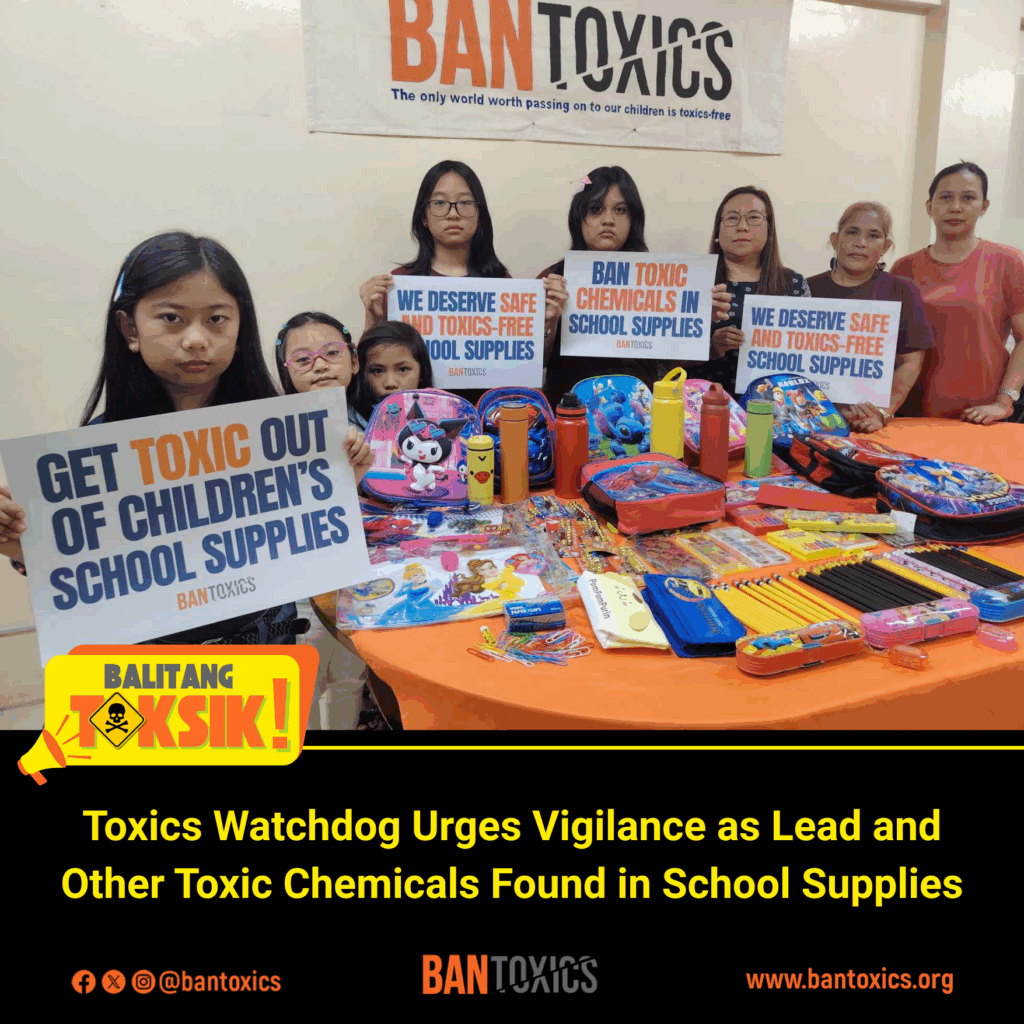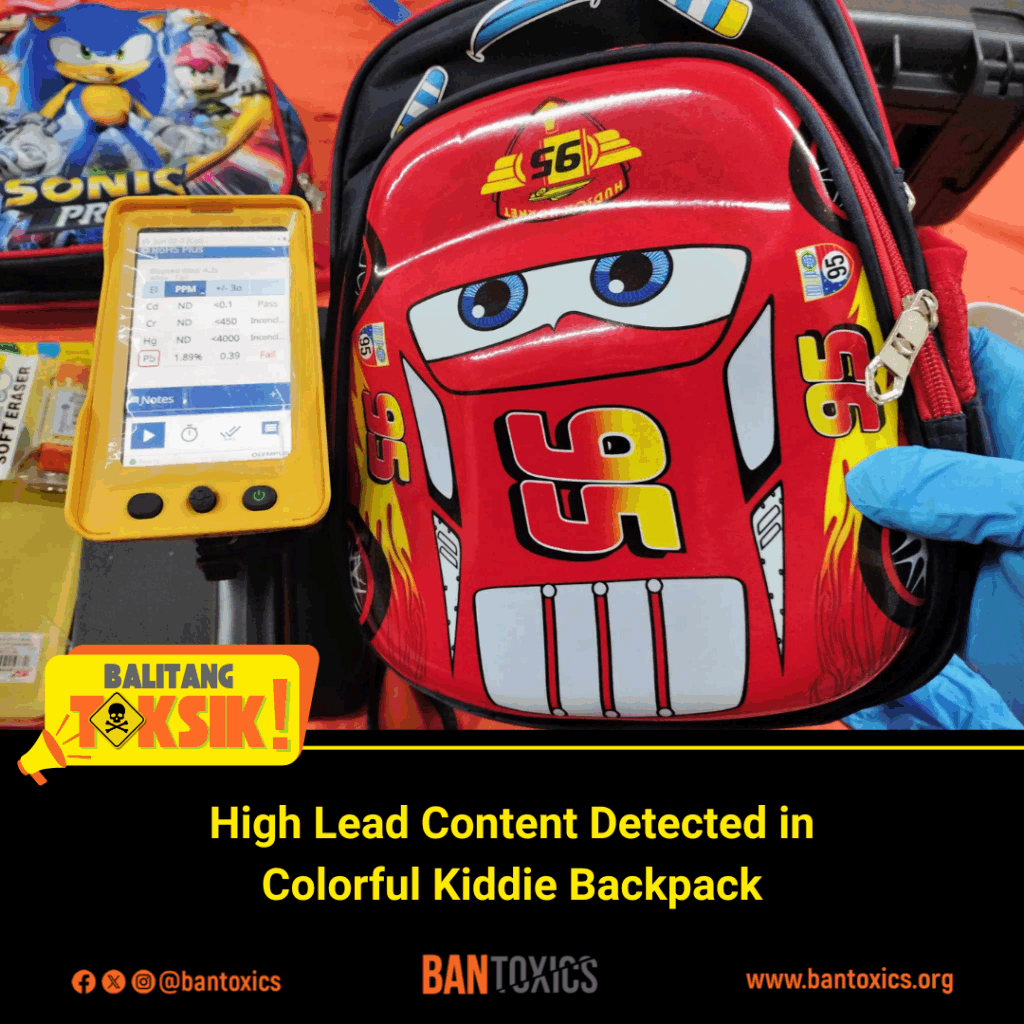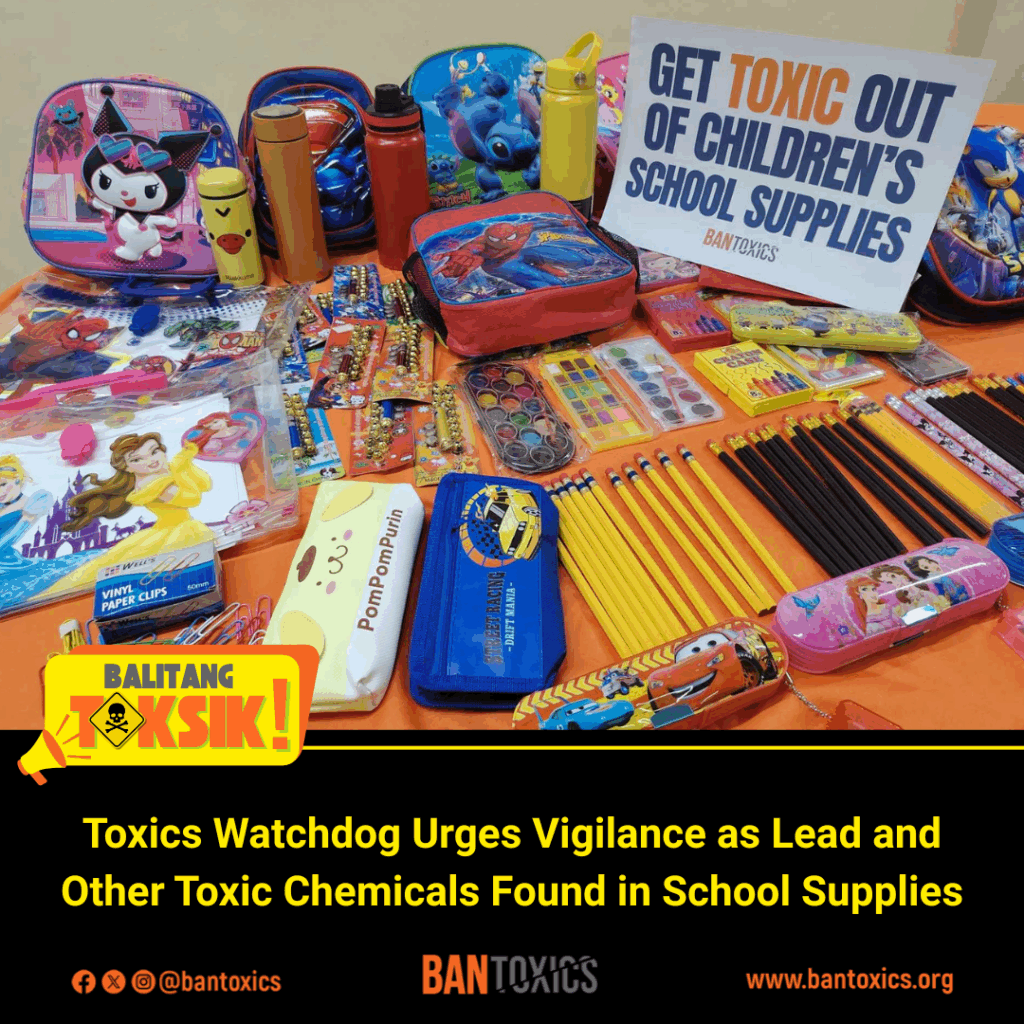03 June 2025 – Chemicals and waste watchdog BAN Toxics has raised urgent concerns over the presence of hazardous substances in some school supplies, urging parents and consumers to take extra caution with the back-to-school season in full swing.
In a recent market sampling, the group purchased and tested 17 types of school items sourced from bargain shops and ambulant vendors in the cities of Caloocan, Manila, Pasay, Quezon City, and Taguig.
Out of 150 samples screened using a Vanta C Series Handheld XRF Analyzer, two school items were found to contain dangerously high levels of toxic lead. A kiddie backpack with a cartoon character design registered 18,900 parts per million (ppm) of lead, while a red-painted water container showed 12,000 ppm—both far exceeding the regulatory limit. Other school supplies, including pencils, crayons, sharpeners, erasers, plastic envelopes, watercolors, and vinyl paper clips, were also found to contain traces of other hazardous chemicals such as arsenic, antimony, barium, cadmium, and chromium.
“It’s really upsetting that every back-to-school season, these harmful items continue to be sold to unsuspecting consumers, putting our children’s health at risk,” said BAN Toxics’ Advocacy and Campaign Officer, Thony Dizon.
Dizon noted that most of the school supplies lack complete product information and warning labels, which are essential for consumer awareness and making informed choices.
“We call on our regulatory agencies such as the Department of Trade and Industry (DTI) and the Food and Drug Administration (FDA) to immediately conduct on-site inspection, test-buys and issuance of health and safety advisory to ensure that only registered school supplies are being sold in the market,” Dizon said.
According to the World Health Organization, lead exposure poses serious health risks to children. High levels of lead can cause severe damage to the brain and nervous system. In extreme cases, it can lead to coma or death. Even lower levels of exposure, which may not show obvious symptoms, can impair brain development and reduce intelligence quotient (IQ). It can also cause behavioural problems such as decreased attention span and increased antisocial behavior. Lead exposure can harm other organs as well. It may cause anemia, high blood pressure, kidney damage, problems with the immune system, and toxicity to the reproductive organs.
In 2013, the Department of Environment and Natural Resources issued a Chemical Control Order (CCO 2013-24) prohibiting the use of toxic lead in children’s products, including school supplies.
In 2018, the FDA released a public health warning about school supplies containing unsafe levels of heavy metals such as lead.
“The existing regulations serve as an important reminder to retailers and wholesalers of school supplies to ensure that only registered and properly notified products are offered to consumers. They must take responsibility to voluntarily remove any items that do not meet the country’s safety standards,” Dizon added.
BAN Toxics has consistently urged the Philippine government to prioritize the passage of a law on safe and non-hazardous children’s products that will safeguard children’s health. Such a law would promote transparency and traceability in chemical use, while enforcing product labeling and safety standards to protect children from the harmful effects of toxic exposure.
BAN Toxics puts forward the following recommendations:
- National government: Enact legislation that prohibits the use of hazardous chemicals in children’s products, including toys and school supplies, to ensure children’s right to safe and toxin-free products.
- Regulatory agencies and local government officials: Establish consumer action centers for immediate product verification and handling of consumer concerns and complaints in public markets and malls. They should also proactively conduct joint post-marketing surveillance and inspections to ensure product safety, quality, and compliance with standards.
- Manufacturers: Comply with existing regulations by securing product certification and providing transparent information about chemical use. They should also consider transitioning to non-toxic ingredients or materials in producing children’s products.
- Sellers: Offer only registered and notified school supplies that comply with safety and labeling requirements, ensuring that consumers have access to safe and non-toxic options.
- Consumers: Always check and read labels before purchasing, seek product information and FDA certification, avoid colorful fabrics that may contain lead, avoid plastic PVC school supplies that may contain phthalates, and report unsafe products to regulatory agencies.
BAN Toxics actively advocates for the safety and protection of children from exposure to hazardous chemicals. One of its core initiatives is the Toxics-Free and Waste-Free School Program (TFSP), which encourages educational institutions to implement sound chemical and waste management practices. This program aims to safeguard students and the school community from the harmful effects of toxic chemicals and hazardous waste. #
References:
https://www.who.int/news-room/fact-sheets/detail/lead-poisoning-and-health
https://www.fda.gov.ph/wp-content/uploads/2022/05/FDA-Advisory-No.-2018-008.pdf
https://chemical.emb.gov.ph/wp-content/uploads/2017/03/DAO-2013-24-CCO-Lead.pdf




